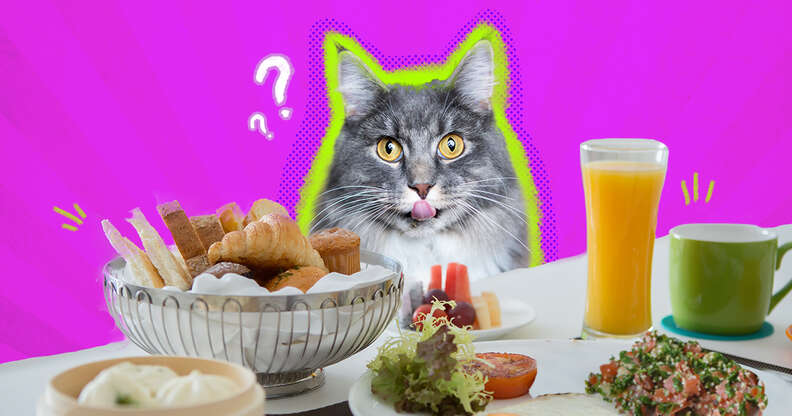What Human Foods Can Cats Eat?
Sharing is caring ❤️

Does your cat give you puppy dog eyes (aka kitty cat eyes) when you pull out a snack?
It’s hard not to share your food with your cat, especially when he’s clearly hangry (even though you JUST fed him). But just because a food is safe for humans to eat, doesn’t mean it’s OK for your cat.
The Dodo spoke with Dr. Jennifer Coates, a veterinarian in Fort Collins, Colorado, to find out which foods are safe for cats to eat — and which foods your cat should totally avoid.
Foods that are safe for cats to eat
Cats are obligate carnivores, which means they need a meat-heavy diet to survive. While your cat can still eat things like vegetables and grains occasionally, he won’t benefit from it much, and in some cases might not be able to digest it fully.
“[Cats] lack the ability to taste anything sweet,” Dr. Coates told The Dodo. “Therefore, they tend not to be drawn to fruits, vegetables or grains.”
But even though your cat doesn’t have a sweet tooth, it doesn’t mean he won’t pull out all the stops to get a bite of your avocado toast.
Some cats enjoy the texture of grains, vegetables or fruits. Others may be looking to add fiber to their diet to help their digestion.
Not all fruits, vegetables or grains are good for cats, though. Take a look at the list below to see what’s cat-safe, and what you should keep him away from.
Grains
Some cats like grains because of the texture, especially smaller grains like couscous.
Rice, oats, polenta and other grains are perfectly fine in small amounts. But keep in mind that loading your cat with carbs can easily lead to weight issues — so carbs shouldn’t be the main part of a cat’s diet.
Vegetables
Ever caught your cat gnawing on a plant outside? Cats will eat plants and other roughage to aid in digestion.
If your cat is an avid plant-eater, you can try adding cat-safe grass to your home — or you can serve plain, cooked veggies on occasion.
Try this pet grass from Amazon for $11.46
Here are some veggies that are safe to feed to your cat. Remember, make sure these veggies are cooked and served plain.
- Carrots
- Spinach
- Peas
- Broccoli
- Cauliflower
- Asparagus
- Pumpkin
- Winter squash
Fruits
Fruits might be delicious for people, but they won’t be most cats’ first choice of snack — mainly because cats can’t taste anything sweet.
That might not apply to your cat, though; some cats are just different and might like the texture of fruits.
Fruits are typically high in sugar, so like with all human foods, feed in small amounts. (Even though cats can’t taste it, sugar’s still not great for them.)
You can safely feed the following fruits to your cat.
- Bananas
- Blueberries
- Cantaloupe
- Melon
- Strawberries
- Raspberries
- Mangoes
- Apples
- Apricots
- Cranberries
Meat and fish
“Small pieces of cooked, lean meat or fish (no skin, fat or bones) make a wonderful treat for cats,” Dr. Coates said.
This doesn’t mean you can toss your cat a steak and call it a day. Make sure you remove the skin, bones and fat before serving, Dr. Coates said.
Raw meat and fish can be dangerous, so make sure the protein is cooked thoroughly.
Fish has loads of omega-3 fatty acids, which are great for a cat’s heart, kidney and bones.
Be careful to not feed your cat too much fish that has a lot of mercury, like tuna and salmon, which can be dangerous.
Dr. Coates recommends that cat parents serve bonito flakes, also known as katsuobushi and often used in Japanese cuisine, to their cats as a safe prepared snack. Bonito flakes are thin, dried flakes of tuna, and cats often love them.
“Cats not only enjoy their taste, but when they are placed on top of something warm and steamy (lightly microwaved canned cat food, for example) they move [because of their thin structure], which is sure to grab a cat’s attention,” Dr. Coates said.
Try these bonito flakes for cats from Amazon for $14.99
Low-lactose dairy
The idea that cats can drink a bowl of milk with no problems at all is a total myth. In reality, most cats are lactose intolerant.
While dairy is commonly considered to be an unsafe food for cats, some cats may be able to handle small amounts of yogurt or sour cream, as well as milk and cheeses that are low in lactose.
If your cat starts to have stomach problems after a few tries, though, definitely avoid giving dairy to your cat in the future.
Eggs
Eggs contain lots of protein as well as taurine, which is a key amino acid in a cat’s diet.
Be careful not to give your cat eggs that have loads of salt or other seasonings, though, which can be harmful.
Also, uncooked eggs may contain salmonella. Be sure to scramble or boil the eggs to prevent serving raw egg to your cat.
Foods that are bad for cats
Cats can safely eat small amounts of most fruits, vegetables and grains safely — but there are some foods that your cat needs to avoid at all costs.
If you’re ever in doubt about whether your cat can eat something, make sure you check with a vet first — especially if your cat’s on a special or restricted diet.
We independently pick all the products we recommend because we love them and think you will too. If you buy a product from a link on our site, we may earn a commission.